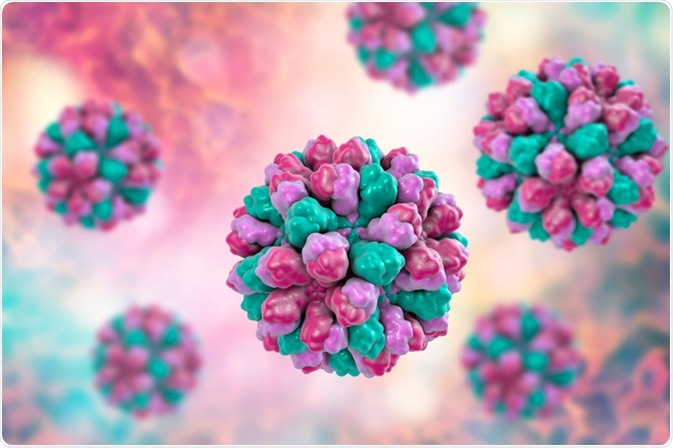Diagnosis of norovirus infection, one of the most common causes of acute gastroenteritis, can be presumed based on the clinical presentation. “Kaplan-criteria” are highly indicative for norovirus outbreaks: an incubation period of 15-50 hours, diarrhea, vomiting in more than one-half of cases, average symptom duration between 12 and 60 hours, a high attack rate, and stool samples that test negative for bacterial or parasitic pathogens.
 Image Credit: Kateryna Kon/Shutterstock.com
Image Credit: Kateryna Kon/Shutterstock.com
Different attempts to successfully develop a technique for the cultivation of noroviruses were futile. The availability of more sensitive diagnostic methods has radically changed our appreciation of the epidemiology of norovirus disease, which resulted in strategies for prevention and treatment of this easily transmitted viral agent.
Laboratory detection
Laboratory diagnosis of norovirus infection is primarily based on electron microscopy and molecular biological techniques. Electron microscopy detects virus particles with 27 to 30 nm in diameter and allows the detection of many viruses, as well as their basic typization. However, diagnosis by electron microscopy can yield false negative results due to the high detection limit of at least one million particles per milliliter of stool.
The cloning and sequencing of the complete genome of Norovirus genus has resulted in the development of molecular detection methods. The reverse transcriptase-polymerase chain reaction (RT-PCR) assay is used to detect the viral genome in stool samples, generally proved more sensitive than electron microscopy. Most assays target the viral RNA-dependent RNA polymerase or the major capsid protein, with an additional advantage of genotyping by partial sequence.
REAL-TIME TaqMan and SYBR Green techniques quantify specific DNA or RNA sequences and gene expression in clinical material from emitted fluorescence detection since the first amplification cycle. Higher specificity, sensitivity and reproducibility are advantages when compared to the regular PCR, in addition to real-time monitoring, elimination of post-PCR product handling and reduced contamination.
The production of virus-like particles and the subsequent generation of hyperimmune sera in mice and rabbits have led to the development of assays based on antigen and antibody detection. Still, the lack of a broadly reactive and sensitive assay has limited their use. The development of new kit generations entailed benefits for quick diagnosis of noroviruses, primarily targeting outbreaks of disease.
Have You Ever Heard of Norovirus?
Principles of treatment
No specific therapy is available for people with gastroenteritis caused by norovirus infection. In cases where dehydration develops, oral fluid and electrolyte replacement is usually sufficient to replace fluid loss. In rare instances there is a need for parenteral administration of fluids, especially when severe vomiting or diarrhea occurs. Nausea, headache and myalgia can be treated with analgesic and antipyretic drugs.
Antimotility agents can be useful, but their use should be restricted to children older than 3 years of age and adults. Antiemetic agents should generally be given only to adults, and antibiotics are of no benefit in treating norovirus infection. Smaller meals and a bland diet may help limit vomiting.
Attempts to evaluate virus inactivation and other possible interventions in transmission pathways have been hindered by the lack of a suitable virus culture system. The drug tazoxanide represents one of the choices to treat diarrhea caused by norovirus, although higher drug effectiveness was demonstrated against rotavirus when compared to other viral pathogens. A specific vaccine could be the best solution for this infectious disease, but it has not been developed yet.
References
Further Reading
Last Updated: Dec 21, 2022